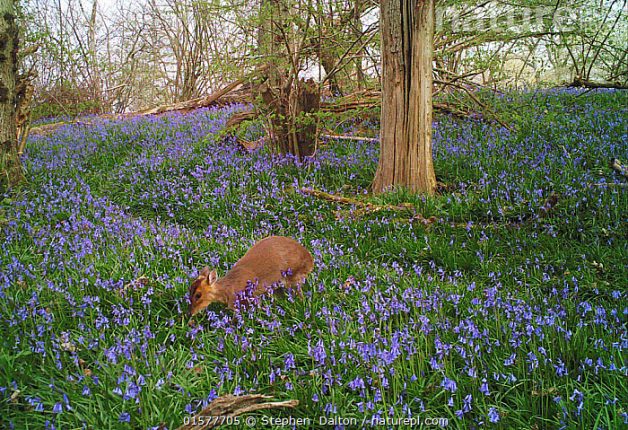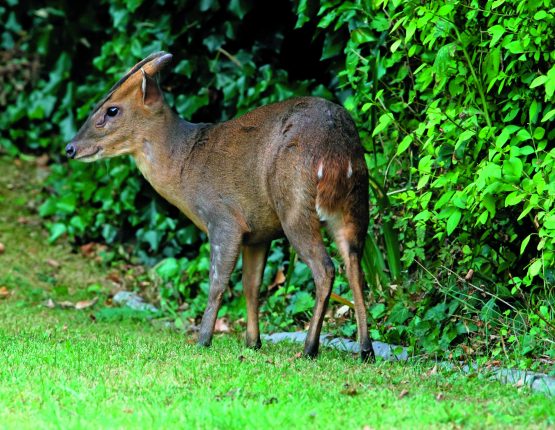Muntjac are thriving but at too great a cost to our woodlands. Managing these little deer is vital and, done properly, it has beneficial – and delicious – results, says Hugh van Cutsem
While out in the countryside, I am sure that an ever-increasing number of you have heard that little rustling noise and then spotted a small, tan-coloured figure with a white, erect tail bound away. Many of you will also, when on a dawn or dusk walk, have noticed a sharp barking noise; vaguely familiar but not so. These are all signs of perhaps one of the strangest invasive/non-native species we have in the UK (although not in Scotland yet, officially). Welcome to the Reeves’ muntjac, Muntiacus reevesi, named after John Russell Reeves, an employee of the East India Company, who discovered them in China and sent specimens back to England in 1838 to Woburn Park. It is from these specimens that future descendants escaped and started to establish themselves outside the confines of the Park. Nearly 200 years on, they are firmly established in most of England and parts of Wales.
MUNTJAC – WHY DO THEY NEED TO BE CULLED?

Their spread has been helped by the fact that they are adaptable animals and can thrive in highly unusual places. They don’t need wild, quiet spaces, being just as at home in urban gardens or small copses growing in the middle of busy roundabouts. Perhaps this hardiness is testament to the fact that they are the oldest-known deer species, appearing up to 35 million years ago with remains found in Miocene deposits in France and Germany. Because muntjac reach sexual maturity at seven months old and have the ability to breed throughout the year, every seven months, they are spreading rapidly.
Sadly, although these deer are delicious to eat, many game dealers will pay little to nothing for a carcass and so not nearly enough are being culled every year. This in turn has made them a central target for reduction across the landscape as the Forestry Commission and the Government gear up to see a huge increase in the number of trees being planted. It is quite clear, from the consultation carried out last year on the England Deer Management Plan, that deer managers are going to be given an ever-expanding number of tools to help them tackle the growth in deer numbers. However, until muntjac are considered more valuable for their meat, we will struggle to see a successful management plan for the muntjac population. That is unless we can encourage more people in the countryside, who manage these diminutive yet fascinating animals, to consume them on their own plates.

While there is no doubt that overpopulation has a negative impact on our woodlands and gardens (their severe impact on coppice regeneration is a perfect example of the damage they can do), if well managed, then muntjac can become a welcome addition to the diversity of the fauna of our landscape. We are envied by many of our hunting brethren in Europe for the fact that we have them running wild in our countryside; they will pay large sums of money for the opportunity to come over here and stalk them. Given how far muntjac have spread, perhaps anyone with access to land that they can shoot on should start paying more attention to the sport that stalking these deer can give while playing an important part in reducing their numbers to a manageable level.
GETTING STARTED
So, what is required to start filling your freezer with prime venison and protect your flora and gardens at the same time? First off you need to have a firearms certificate and permission to shoot deer written into it as well as the certificate either being ‘open’ or the police having approved the ground over which you plan to shoot. The travails some police forces are having within their licensing departments has been well documented, so anyone thinking of applying shouldn’t dawdle.

In terms of rifles and scopes, one can spend a lot or a little: you don’t need to shell out a fortune on a rifle, and there is an array of affordable entry-level rifles from the likes of Sauer, Tikka and so on. However, do invest in a good scope: lightgathering ability is key. In terms of calibre, legally you need a minimum of .220 or .22- 250 and a minimum bullet weight of 50gr. Anyone with little experience of deerstalking should definitely get out and do a Deer Stalking Certificate Level 1 course. A number of organisations, including the British Deer Society, run these.
Such courses are also a brilliant way to further your knowledge of the deer of the UK, their ecology and habitat, as well as helping to ensure they are culled with their welfare being paramount. With muntjac there are some important aspects to learn, particularly in terms of when to shoot the does, in addition to learning marksmanship skills among a myriad of other skills needed for deerstalking. A course provides an excellent entry point into deerstalking. It should also teach you about carcass handling and how to ensure that, once you have taken an animal, you do everything possible to ensure that you have the best possible venison for consumption afterwards.

If you only want to take deer for the table, then there’s no reason to go to the expense of a purpose-built deer larder. Look online and you can find old drinks fridges that can easily be converted to hang a muntjac or roe carcass in. I’m sure at this point that some of you are thinking, ‘that’s all great but how do we do the next stage – the butchery?’ This really isn’t as daunting as some might think it is. There are so many helpful videos that can be found on YouTube that demonstrate every part of the process. It’s not that difficult once you start and, most importantly, you can’t really make a mistake – you will still have prime venison, just perhaps cut in a slightly ‘different’ way. The satisfaction to be had from venison taken from the field to your family’s plate, quite aside from the well-documented benefits of this meat source, is enormous.
I firmly believe that the face of shooting in the UK is slowly changing. Many of those who are setting out into the field want to come home having had an experience different to that which they have in their everyday life. Muntjac – along with their growing range across our country – help provide exactly that opportunity. Imagine being offered the chance on a shoot day to get out at first light after a muntjac and then, after a hearty breakfast, swapping rifle for shotgun to walk the hedgerows and spinneys for pheasants and other gamebirds, perhaps the odd pigeon if you have made the necessary legal arrangements, before finishing the day with flighting some wild duck into a pond. What a day that would be. Nothing to do with the bag size and everything to do with the experience that you’ve shared with a group of friends in the countryside, harvesting wild game and then taking that bounty home to put on the table.
I often wonder now whether many of the guns on big driven shoots come away with any real idea of the work that takes place throughout the year on the land. Give people the opportunities that I have outlined and they will spend far more time talking to the keeper and others involved with giving them that experience. Ultimately it might change the whole angle of the cost of a shoot, particularly at a time when the price of poults, assuming one can get them, is rocketing. Why not look at drastically reducing the numbers of birds released, and therefore the cost, and instead focus on habitat management for wild game?
BUILDING KNOWLEDGE
If you are lucky enough to have your own patch of ground that you can shoot on and you have seen muntjac, there are a number of ways for the novice stalker to understand what the deer are doing. Most importantly, get out on the ground with a pair of binoculars. By slowly moving around actively looking for these little deer you will soon start to pick up knowledge of their movements. Muntjac are territorial animals and so you will quickly work out their areas. Once you have done this, you might decide to put up some high seats as these are an effective way to stay out of sight and observe and manage deer. I strongly suspect you will be surprised by the number of muntjac you have on the ground. Time and again, when people start to look and then actively manage muntjac, they are amazed by their density. I know of one 1,000-acre farm in the Cotswolds that believed it had muntjac numbers well under control but, as a large amount of new planting was about to start, the owners decided to give the muntjac a proper haircut. From shooting 30 to 40 a year, by increasing focus on them, they suddenly shot 120 the next year and were still seeing plenty about.

So, if you are thinking about stalking muntjac, then my advice to you is to get out there and do it. I am certain you will enjoy every moment of it. Dawn and dusk are magical times of the day to be outside: it’s when the woods and fields are alive with wildlife movement.
We do need to reduce muntjac numbers and until they are more widely appreciated for their culinary benefits, we need to consume them and introduce others to the joys of muntjac venison. This in turn will ensure that we are giving our native flora and forest structures an opportunity to thrive in the face of the severe browsing they face in many parts of England at present.
Muntjac are often represented as public enemy number one in our woodlands – sometimes I feel somewhat unfairly. Stalking them has only made me respect these remarkable and adaptable little deer even more. If those keen to turn their hand to something new decided to venture into our coverts and woodlands after muntjac, I think we’d have a growing appreciation of the wonderful asset they could be within our landscape, when properly managed.





